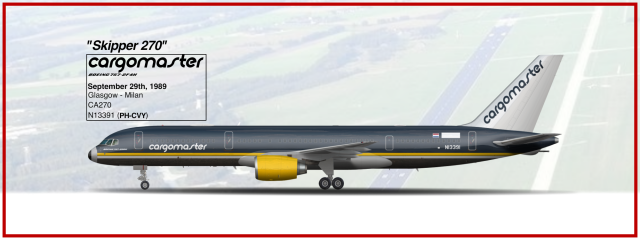
CargoMaster Flight 270
- Owner: Marx (View all images and albums)
- Uploaded: Jan 17 2024 03:05 AM
- Views: 711
- Album Cargomaster
NilsPronk, MED/Airplano21. Accident photos by me.

CargoMaster Flight 270 was a scheduled cargo flight from Glasgow International Airport, Glasgow, Scotland to Milan-Linate Airport, Lombardy, Italy. On the morning of September 29th, 1989, the Boeing 757-2F4H serving the flight suffered an uncontained loss of pitch control at 37,000ft. The airplane was forced into another spiral dive a second time, and soon after the crew of the airplane would execute a successful emergency landing at Volkel Air Base. It was CargoMaster's first incident with a Boeing airframe.
https://ibb.co/GxY6Qtj
https://cdn.fs.brand...=300&format=png
CargoMaster Flight 270, photographed by an amateur dutch photographer flying over Amsterdam. A white trail of vapor can be seen from the stabilizers.
ACCIDENT
Date September 29, 1989
Summary Loss of pitch control caused by incorrect maintenance procedures applied to the Boeing 757-200H
Site Over the English Channel and the Netherlands
Total Fatalities 0
AIRCRAFT
Aircraft type Boeing 757-2F4H
Operator CargoMaster
IATA flight No. CA270
ICAO flight No. CAM270
Call sign SKIPPER 270
Registration N13391
Flight origin Glasgow International Airport
Destination Milan Linate Airport
Occupants 4
Passengers 0
Crew 4
Fatalities 0
Survivors 4
FLIGHT AND CREW
In the morning of September 29th, 1989, Flight 270 took off from Glasgow International Airport. The flight was a scheduled cargo flight operated by CargoMaster using a Boeing 757-2F4H registrated as N13391. The 757 was bound for Milan Linate Airport.
There were 4 occupants in the aircraft: Captain James Sanders, age 49; First Officer Finn Baker, age 47, and two off-duty crew members; Captain Bran Van der Waal, age 45 and First Officer Christtofel De Jong, age 42, both employed by CargoMaster Holland for an inspection of the accident aircraft.
Both Sanders and Baker had previous military experience, with both serving in the U.S. Air Force. Waal and De Jong also had experience with the Royal Netherlands Air Force (RNLAF). All crew members had over 5,000 to 7,000 flight hours on the 757.
INCIDENT
At 11:32 local time, CargoMaster Flight 270 cruised at 37,000ft over the English Channel. Due to the busy aspect of the channel, CargoMaster was directed to climb to 38,000ft to avoid traffic inbound to London. As the autopilot was adjusted to the directed altitude, the crew heard two metallic clank sounds emanating from the yoke. Only a second after the second sound, the 757 suddently pitched up and rolled right, and as the crew attempted to counter the pitch and roll of the aircraft, it soon entered a spiral dive out of 37,100ft.
Four years before the accident flight, N13391, the Boeing 757 involved in the accident, passed through extensive maintenance with a partner maintenance company of CargoMaster's in Florida. The 757H was equipped with a 20mm M61 Vulcan directly underneath the horizontal stabilizers, which prompted Boeing to redesign the systems linking the control column to the stabilizers. The tail remained largely unchanged, but the horizontal stabilizers were extensively modified and required additional training to safely maintain. The partner company in Florida had no knowledge of the changes, and as such the procedures for the normal 757 were applied to the stabilizers rather than the procedures for the modified 757H. This caused extensive wear and prompted the accident flight to show light erratic inputs as reported by the crew members of previous flights. The two metallic clank sounds were linked to the horizontal stabilizers wearing off to the point one of the columns linking the control surfaces to the cockpit snapped off clean, prompting the accident flight to enter an asymmetrical climb and roll; the stabilizers worked like makeshift ailerons due to the failure. Although both control surfaces would reply with a climb if commanded by the yoke, one stabilizer would angle less than the other, thus causing the uncontrolled commands.
---
Cockpit Voice Recorder, including communications with tower.
[11:32:36] INT: Skipper 270, climb and maintain FL380.
[11:32:40] Captain: Climb and maintain FL380, Skipper 270.
[11:32:44] [Sound of first clank]
[11:32:45] First Officer: You got it set up?
[11:32:47] [Sound of second clank, uncommanded climb and right roll begins]
[11:32:47] Off-duty First Officer: Argh!
[11:32:48] Captain: Easy, Easy.
[11:32:48] [BANK ANGLE]
[11:32:48] First Officer: We've hit something.
[11:32:47] Off-duty Captain: Huh?
---
The sudden climb and subsequent spiral dive was also witnessed by two planes; A British Airways Airbus A320-211 (registration G-BUSG) flying as BA 323 from Paris to London and a KLM Boeing 747-406 (registration PH-BFA) with an unconfirmed flight number from Barcelona to London. The latter was in a ferry flight. The crew of the A320 were the first to report the sight of the falling plane; they described it as "A 757 or 767 in an uncontrolled dive, heading for the ocean". The crew of the 747 reported the same soon after, describing it as "A plane on a very steep nose dive, spinning rapidly".
The plane's altitude dropped from 37,000ft to 24,000ft in a matter of around 80 seconds. Reports say the 757 reached a speed of Mach 0.99, with other sources citing Mach 1.17; the latter was never fully confirmed. The crew soon acknowledged the nature of the faulty horizontal stabilizers and were able to stabilize the plane at 24,500ft. After the dive, the crew attempted to contact Amsterdam, as the airport was the closest to the airplane. The off-duty crew assisted in communication as Sanders and Baker did not understand the ATC's initial remarks in Dutch.
[11:34:40] Captain: Center, Skipper 270, we just got out of * a dive.. We may have lost some pitch and roll control.
[11:34:47] AMS ATC: Skipper 270, roger.
[11:34:49] First Officer: Keep the throttles split.
[11:34:47] AMS ATC: Skipper 270, what altitude would you like to remain at?
[11:34:51] Captain: Skipper 270.. keep us around FL200. We're troubleshooting the issue.
[11:34:57] AMS ATC: Copy. 270, descend and maintain FL200.
The crew of the 757 was able to steadily descend to FL200 using differential thrust on both engines while they reviewed their options for an emergency landing. The state of the airplane was almost precarious; using the remote targeting camera installed on the M61 located on the tail, the two off-duty crew members noticed a significant amount of asymmetry in the horizontal stabilizers.
Sanders was the first to suggest the idea that the 757 could fall into another roll or dive any second, and promoted the idea of landing in the closest non-civilian airfield or airbase available. As they discussed their options, the plane soon flew over the skies of the Netherlands. 19 minutes after the initial dive, the crew was still attempting to troubleshoot the problem when a series of uncommanded inputs coming from the re-engagement of the autopilot forced the plane into another, more brutal dive. This time, the crew had a harder time reaching for their controls as the plane performed a quick, sudden dive at 20,000ft over outskirts of the city of Amersfoort.
[11:51:02] [Autopilot Engaged]
[11:51:04] First Officer: Stable?
[11:51:05] Captain: Seems like it. It's a b**** to control.
[11:51:08.5] [Aircraft enters dive, Autopilot Disengagement Alarm]
[11:51:10] Off-duty First Officer: Damn.
[11:51:11] First Officer: Push it up!
[11:51:13] Captain: Skipper 270, emergency.
The aircraft plunged from 20,000ft to nearly 6,000ft. The crew resorted to inverting the plane in order to stabilize it, with the townsfolk of both Amersfoort and Hilversum watching the 757 as it plunged and subsequently stabilized itself.
https://cdn.fs.brand...=300&format=png
N13391 on it's second dive just after inverting, photographed by another amateur dutch photographer in the outskirts of Amersfoort
After the second dive, Waal and De Jong communicated with another frequency in the Dutch airspace related to Schiphol. Of all the available civilian airports and airbases, Volkel Air Base was eventually suggested by ATC. Although the plane was near Amsterdam, the second plunge showed that the plane could be forced into an irreversible dive on populated areas, potentially causing the deaths of dozens. Upon the selection of Volkel, the two off-duty crew members kept communicating with ATC, and soon after the air base in which the 757 would land into. The 757 was cleared to climb to FL090 in case of another dive, with the autopilot's instability forcing the crew to fly the plane manually.
The 757 quickly flew through the Netherlands, and soon approached Volkel air base. However, the plane was too high and too fast, which led the crew into making a series of actions deemed outrageous in modern aviation. First, the speedbrakes were applied and thrust lowered, allowing the plane to slow down steadily. Soon after that, Sanders executed a Forward Slip by applying left rudder and right ailerons. 3 years prior to the accident, First Officer Baker and Captain Sanders both studied the outcome of Air Canada 143; unlike the crew of the Air Canada flight, the crew of the CargoMaster flight had minimum experience with glider aircraft, something that likely affected the outcome of the latter.
Almost an hour after the initial failure, the crew of N13391 touched down on Volkel Air Base. Due to an irregular airspeed, the 757 bounced in it's landing and the nose gear subsequently impacted the runway at a high speed, causing a collapse and forcing it back into it's well. Without it's nose gear, the plane slightly veered into grass by the side of the runway. Both Sanders and Baker applied brakes, spoilers, and thrust reversers to slow the plane down as much as possible; a Dutch F-16 almost collided with the 757 on a taxiway connected with the runway as it stood by. Seconds later, the plane was surrounded by dozens of emergency vehicles. The crew left the aircraft from the right front door of the plane, in which an emergency slide was deployed.
AFTERMATH
https://cdn.fs.brand...=300&format=png
N13391 in 2016, as PH-CVY.
All 4 crew members were awarded the Gold Medal Award for heroism by the Air Line Pilots Association. After a series of physical and mental evaluations, the crew of N13391 were allowed to return to the skies with CargoMaster and CargoMaster Holland. The accident aircraft was subjected to 600,000 dollars worth of damage, and was only allowed to return to the skies after it's horizontal stabilizers were reviewed and properly maintained. For 4 months, CargoMaster's fleet of 757s and 767s was grounded until all changes were implemented by CargoMaster and the FAA. The accident aircraft was re-registered PH-CVY and entered service with CargoMaster Holland shortly after leaving Volkel. The airframe would serve the airline for a total of 32 years before being retired in 2016. The airplane was bought by the Royal Netherlands Air Force, and is now stationed and preserved at Volkel Air Base. It has recently been used in NATO exercises involving electronic warfare systems,
Sanders retired from his pilot career in 1997; Baker would retire 6 years later in 2003. Waal and De Jong would serve for CargoMaster Holland until 2008.

 Sign In
Sign In Create Account
Create Account












Seems like they botched the images, they're appearing as URLs. Really Sorry!